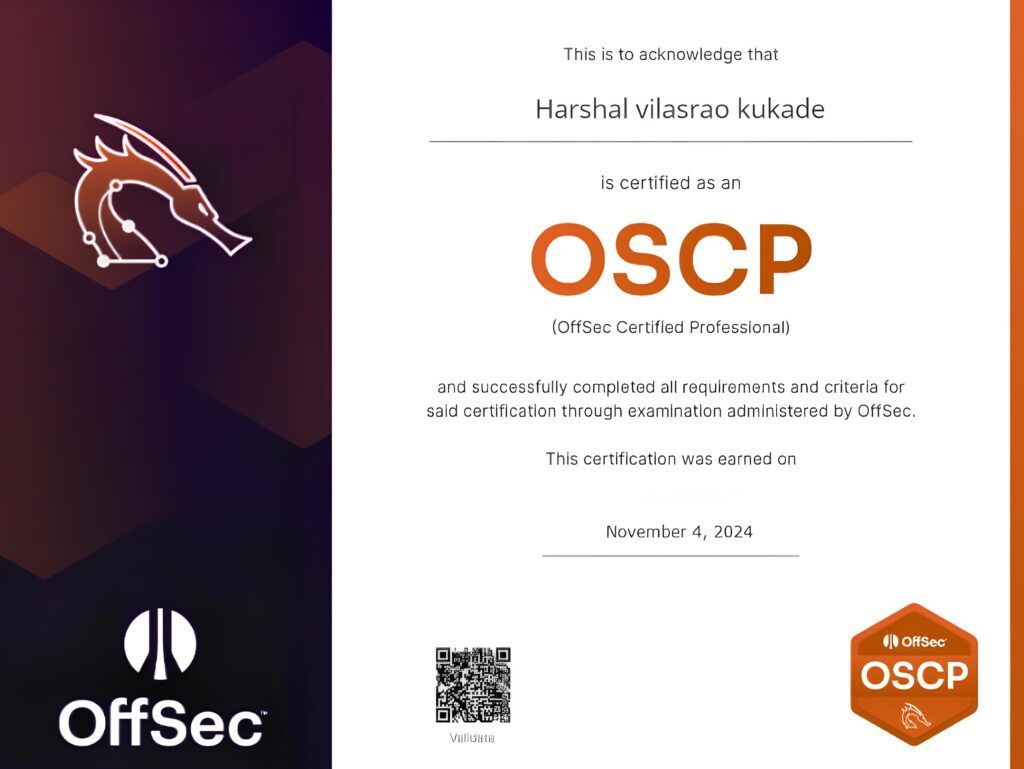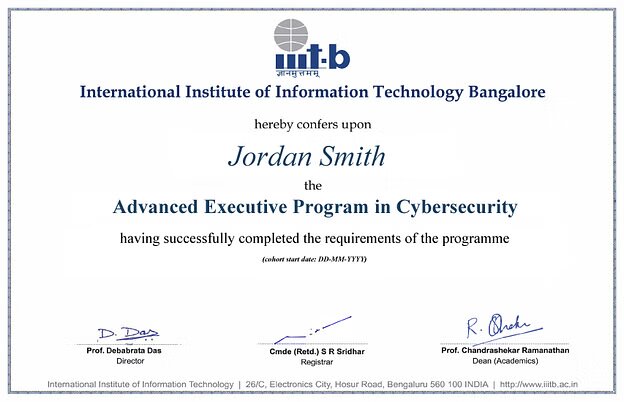- +91 9850352569
- 24x7
6 months
Online Bootcamp
22 Jun, 2024
India Today’s 2021 survey ranks us as the top Technical University (Private) in India
Get Access to the IBM Portal and earn industry-recognized IBM course certificates.
Live online classes on new cutting-edge genAI, threat intelligence, and advanced defense strategies.
Strengthen your resume and get interview-ready with valuable insights from industry professionals
An information security analyst safeguards an organization’s digital assets and sensitive information from cyber threats and data breaches. They assess IT infrastructure and develop strategies like firewalls, encryption, and authentication to ensure confidentiality and prevent potential threats.
12Lakhs to 30Lakhs Per Annum


Ethical hackers, also known as penetration testers, are hired by organizations to identify vulnerabilities in their systems and networks by simulating cyberattacks. They help organizations strengthen their security by finding and fixing weaknesses before malicious hackers can exploit them.
18-45 Lakh Per Annum


22 Lakhs – 1cr Based on experience and skillsets









Get started with the Advanced Executive Program in Cybersecurity in collaboration with IIIT Bangalore and IBM. Explore everything about this unique program covering advanced cybersecurity concepts and kickstart your journey as a cybersecurity professional.
The Enterprise Infrastructure Security course will enable learners to gain knowledge and skills in a series of advanced and current concepts in cyber security, and related to enterprise and infrastructure security. After the completion of this module, learners will have a comprehensive understanding of the NICE framework, security controls, networking concepts, traffic analysis, packet analyzers, sniffers, firewalls, SIEM, VLAN, VPN, identity and access management, and much more.
The Application and Web Application Security course will enable learners to gain knowledge and skills in OWASP tools and methodologies, insecure deserialization, clickjacking, black box, white box, fuzzing, symmetric/asymmetric cryptography, hashing, digital signatures, API security, patch management, and much more.
Malware, specifically ransomware, costs businesses more than $75 billion per year. These attacks continue to be a threat to the security of companies. In this module, you will get an overview of how to detect, analyze, and protect yourself and your company from ransomware attacks.
This module provides you with the hands-on training required to master the techniques hackers use to penetrate network systems, helping you fortify your system against it. You will also gain an understanding of the finer nuances of advanced hacking concepts, penetration testing, and vulnerability assessment.
This module lets you apply cybersecurity skills learned in the program. Solve real-world challenges through projects, practice industry problems, and showcase your abilities to employers.
Introduction to Ethical Hacking
What is Hacking
Who is a Hacker
Skills of a Hacker
Types of Hackers
Reasons for Hacking
Who are at the risk of Hacking attacks
Effects of Computer Hacking on an organization
Network Security Challenges
Elements of Information Security: Confidentiality,
Integrity & Availability
The Security, Functionality & Usability Triangle
What is Ethical Hacking
Why Ethical Hacking is Necessary
Scope & Limitations of Ethical Hacking
What is Penetration Testing
What is Vulnerability Auditing
Computer and Network Basics:
Hacking
Internet protocol
Types of IP
Port
Protocol
Protocol service
OS for different hardware platforms
Vulnerability
Different Programming languages for different
platforms/purposes.
What are Networks and what is networking
Network topologies
How the Networking devices communicate.
Vulnerable Hacking environments
Hashing checksums
Window/Linux commands
Php code overview
Assembly language programming overview
Introduction of kali
Introduction of backtrack
Introduction of parrot
Kali Linux
What is Kali Linux
How Kali Linux is different from other Linux
distributions
What are the uses of Kali Linux
What is Metasploit framework.
Tools for Footprinting, Scanning & Sniffing
Using Metasploit framework to attack Windows
Passive Sniffing
What is promiscuous mode
How to put a PC into promiscuous mode
What is ARP
ARP poison attack
Threats of ARP poison attack
How MAC spoofing works
MAC Flooding
What is a CAM Table
How to defend against MAC Spoofing attacks
How to defend against Sniffers in network
System Hacking
What is system Hacking
Goals of System Hacking
Password Cracking
Password complexity
Finding the default passwords of network devices and
softwares
Password cracking methods
Online password cracking
Man-in-the-middle attack
Password guessing
Offline password cracking
Brute force cracking
Dictionary based cracking
Hybrid attack
USB password stealers
Elcomsoft Distributed password recovery tools
Active password changer
What is a Keylogger
How to deploy a Keylogger to a remote pc
How to defend against a Keylogger.
Malware Threats
What is malware
Types of malware
Virus
What is a virus program
What are the properties of a virus program
How does a computer get infected by virus
Types of virus
Virus making tools
How to defend against virus attacks
Worm
What is a worm program
How worms are different from virus
Trojan
What is a Trojan horse
How does a Trojan operate
Types of Trojans
Identifying Trojan infections
How to defend against Trojans
Spyware
What is a spyware
Types of spywares
How to defend against spyware
Rootkits
What is a Rootkit
Types of Rootkits
How does Rootkit operate
How to defend against Rootkits
Phishing and Social engineering
What is Phishing
How Phishing website is hosted
How victims are tricked to access Phishing websites
How does an IDS work
SPAN
IDS tools
What is a honeypot
Types of honeypots
Honeypot tools
Honeypot detection tools
IoT Hacking (New)
Different threats to IoT platforms and learn how to
defend IoT devices securely.
Cloud Computing
What is Cloud
What are the cloud services
Various cloud computing concepts, threats, attacks,
and security techniques and tools (Cloud security).
Stenography
Stenography
Cryptography
What is Cryptography
Types of cryptography
Cipher algorithms
Public key infrastructure
What is a Hash
Cryptography attacks
Penetration Testing
What is Penetration Testing
Types of Penetration Testing
What is to be tested
Testing the network devices for misconfiguration
Testing the servers and hosting applications for
misconfiguration
Testing the servers and hosting applications for
vulnerabilities
Testing wireless networks
Testing for Denial of Service attack
Counter Measure Techniques for Network level attacks
Types of Firewall
Packet Filtering Firewall
Circuit-Level Gateway Firewall
Application-Level Firewall
Foot Printing/reconnaissance/Information Gathering
What is Foot Printing
Objectives of Foot Printing
Finding a company’s details
Finding a company’s domain name
Finding a company’s Internal URLs
Finding a company’s Public and Restricted URLs
Finding a company’s Server details
Finding the details of domain registration
Finding the range of IP Address
Finding the DNS information
Finding the services running on the server
Finding the location of servers
Traceroute analysis
Tracking e-mail communications
Scanning
What is network scanning
Objectives of network scanning
Finding the live hosts in a network
Finding open ports on a server
Finding the services on a server
OS fingerprinting
Server Banner grabbing tools
What is a Vulnerability Scanning
Vulnerability Scanner tools
Finding more details about a vulnerability
What is a proxy server
How does proxy server work
Types of proxy servers
How to find proxy servers
Why do hackers use proxy servers
What is a TOR network
Why hackers prefer to use TOR network
Enumeration:
SNMP Enumeration
SMTP Enumeration
DNS Enumeration
Vulnerability Analysis (New)
Perform vulnerability analysis to identify security
loopholes in the target organization’s network,
Communication infrastructure and end systems.
Sniffing and Sniffers
What is a sniffer
How sniffer works
Types of sniffing
Active sniffing
How to differentiate a Phishing webpage from the
original webpage
How to defend against Phishing attacks
SET: Social Engineering Toolkit
DOS : Denial of Service
What is a DOS attack
What is a DDOS attack
Symptoms of a Dos attack
DoS attack techniques
What is a Botnet
Defending DoS attacks
Session Hijacking
What is session hijacking.
Dangers of session hijacking attacks
Session hijacking techniques
Cross-Site scripting attack
Session hijacking tools
How to defend against session hijacking.
Hacking Web Servers & Web Applications
What is a web server
Different webserver applications in use
Why are webservers hacked & its consequences
Directory traversal attacks
Website defacement
Website password brute forcing
How to defend against web server hacking
SQL Injection
What is SQL Injection
Effects of SQL Injection attacks
Types of SQL Injection attacks
SQL Injection detection tools
Wireless Network Hacking
Types of wireless networks
Wi-Fi usage statistics
Finding a Wi-Fi network
Types of Wi-Fi authentications
Using a centralized authentication server
Using local authentication
Types of Wi-Fi encryption methods
WEP
WPA
WPAT
How does WEP work
Weakness of WEP encryption
How does WPA work
How does WPAT work
Hardware and software required to crack Wi-Fi
networks
How to crack WEP encryption
How to crack WPA encryption
How to crack WPAT encryption
How to defend against Wi-Fi cracking attacks
Android Hacking
Android Hacking Online and Offline.
What is Metasploit framework.
Using Metasploit framework to attack Android
mobile devices.
Evading Firewalls, IDS & Honeypots
What is a Firewall
What are the functions of a Firewall
What is an IDS
Stateful Multilayer Inspection Firewall
Limitations of a Firewall
IDS / IPS
What is an IDS
What is a IPS
Difference between IDS & IPS
Placement of IDS in the Network
Configuring an IDS in the Network
Placement of IPS in the Network
Configuring an IPS in the Network
UTM / Next-Generation Firewall
What is a UTM
Features of UTM
Difference between a Firewall & a UTM
Placement of UTM in the Network
Configuring a UTM in the Network
Monitoring attacks using UTM
Configuring IPS module in UTM to detect and stop
attacks
Counter Measure Techniques for Local Systems
Identifying the Vulnerabilities of a system
Understanding the Vulnerabilities of a system
CVE ID
Bugtraq ID
Patch Management
Identifying the patch for a Vulnerability
Downloading the Patch
Testing the patch for stability in test environment
Deploying the patch to Live Network
Finding the missing updates in an Operating System
Microsoft Baseline Security Analyser
Belarc Advisor
Counter Measure Techniques for Malware Attacks
Scanning systems for Malware infections
Types of anti-malwares
Anti-Virus
Anti-Worm
Anti-Trojan
Anti-Rootkit
Internet Security Suites
HIDS
HIPS















The increasingly interconnected digital world makes it imperative that organizations have individuals capable of safeguarding sensitive data, networks, and systems. There is a significant shortage of cybersecurity experts globally, creating a lucrative job market for those with the requisite skills and certifications.
The Advanced Executive Program in Cybersecurity from IIIT Bangalore is one of Simplilearn’s top cybersecurity courses in India that addresses this skills gap by providing comprehensive training in various domains. This certification program meets the high demand for cybersecurity professionals by equipping students with the necessary skills and knowledge to excel in this critical field. Its practical, hands-on approach ensures students gain valuable experience, while the globally recognized certification opens up job opportunities worldwide.
A cyber security certification, like the one offered by IIIT Bangalore, holds significant value as it validates your expertise and knowledge in the field, demonstrating to potential employers or clients that you possess essential skills and competencies. Earning a cyber security certificate can advance your career by enhancing your credibility, opening up new job opportunities, and potentially leading to higher-paying roles in the rapidly growing field of cyber security.
Yes! IIIT Bangalore provides an Advanced Executive Program in cybersecurity. Industry experts have designed this comprehensive course to offer participants an immersive learning experience with practical, real-world applications.
A cyber security course online can provide invaluable knowledge and skills in the domain by offering a comprehensive curriculum on network security, cryptography, and ethical hacking. Through interactive modules and real-world simulations, participants can learn to effectively identify and thwart cyber threats. Additionally, access to expert instructors and an excellent learning support network fosters a collaborative learning environment, enabling practical application and continuous improvement of cybersecurity prowess.
A cyber security certification online course typically covers topics such as network security, cryptography, ethical hacking, risk management, security policies and procedures, malware analysis, incident response, and information security best practices. This cyber security bootcamp covers topics like NICE framework, security controls, networking concepts, sniffers, firewalls, traffic analysis, packet analyzers, SIEM, VLAN, VPN, identity and access management, OWASP tools and methodologies, insecure deserialization, black box, white box, fuzzing, symmetric/asymmetric cryptography, hashing, digital signatures, API security, patch management, ransomware and malware analysis and much more.
The eligibility criteria to enroll in a cyber security course online varies based on the course curriculum. The eligibility criteria for this advanced executive program are as follows:
The time required to finish a cyber security certification online varies based on the course curriculum and modules. For instance, the advanced executive program provided by IIIT Bangalore can be accomplished within a span of 6 months.